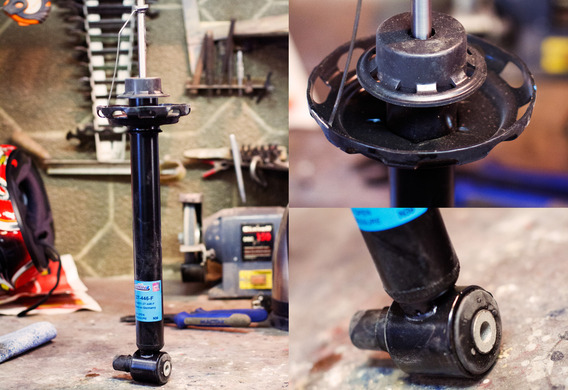
Appointment
The shock absorber is used to extinguash the shocks and tremors that get the body of the car through the wheels during motion. In addition, the shock absorber provides reliable contact with the road wheels. So his appointment is not only comfort, but also security.
The first vehicles were not equipped with shock absorbers. Their function was performed by vibrations-vibrations through the friction of steel sheets with each other. As the speed at which cars were able to move, grew constantly, for comfort and safety, new systems had to be invented. For example, the shock absorbers were in the form of a package of compressed friction discs. This worked as follows: the disks were turning relative to each other with the effort that vibrated. Such a design had to be abandoned after some time, as the disks had been overheated and were quickly worn out.
The solution was found in the 20th century. The solution to the problem was the use of liquid, which caused the vibration of the body to vibration, moving under pressure from one receptacle to another.
Device and operating principle
The shock absorbers can be divided into several basic types. They are usually divided into one-and two-pipe structures.
The shock absorbers differ in the nature of the liquid in which they are filled: hydraulic and gas (hydraulic). There are also gas shock absorbers, which are under very high pressure (about 60 atm), but are rarely used. The same type of work is similar to all types.

To understand how the shock absorber works, and more precisely what this work is to do, it is necessary to imagine its interaction with other parts of the suspension and body of the car. The shock absorber is designed to reduce the variation of the car body vibration caused by the elastic element. Such an element may be a shock absorber, which is attached to it. This design is called the shock absorber. The upper part is connected to the body of the machine and the lower part is connected to the lever. Therefore, the extent to which the springs and springs will be gently raised and lowered depends directly on the easing of the movement of parts of the shock absorber itself.
Now stop more on the general shock absorber device. The shock absorber is based on hydraulic resistance or gas resistance. The fluid is oil. There are a variety of shock absorbers in which, in addition to the oil, the resistance gives a shimmering and gas-burning gas.
The shock absorber can be conditionally divided into a cylinder and a piston. Inside the cylinder, depending on the modification, there are cameras either with oil and gas or with oil and air. In both cases, the piston goes inside the cylinder, rising and falling. In the first case, the piston is moved with resistance, which is created by transferring the oil through the valves to another chamber. In the second, piston resists the pressure exerted by the burning gas chamber. It is important to understand that such resistance occurs because the gas is rather poorly compressed and compacts. It turns out that, at the expense of these resistors, there is a smooth, measured movement of piston, which results in a glowing effect.
Operations
It is not particularly difficult to identify problems related to the operation of the shock absorber: when the car is hit, the characteristics of the car vibrate are noticeably shaking. The main problem with this device is that this process is taking place gradually, with the exception of gas-oil shock absorbers, which can be immediately inoperable. Thus, the driver can adjust to the changing behaviour of the car and not hurry to repair. Meanwhile, the braking distance and wear of tires are increasing, and the steering is deteriorating. On the one hand-change, on the other hand, the shock absorbers may have a significant impact on the shock absorbers.
For motor vehicles equipped with electronic braking systems (ABS, EBD, etc. (d) Failing shock absorbers often result in electrical failures.









